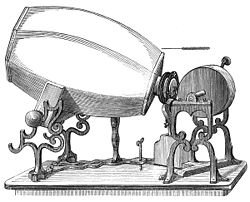1860: The First Recording of the Human Voice
On the 9th of April 1860, a remarkable event took place that would forever change the course of technology and human history. Édouard-Léon Scott de Martinville, a French inventor and printer, achieved a groundbreaking feat by creating the first known recording of the human voice.
Scott’s invention, known as the phonautograph, was a marvel of its time. Unlike later technologies that allowed for playback, the phonautograph was designed solely to visually represent sound waves. It consisted of a vibrating diaphragm attached to a stylus, which would etch the sound waves onto a rotating cylinder covered in soot-blackened paper.
Using this ingenious device, Scott recorded a short clip of the popular French folk song “Au Clair de la Lune.” Although the phonautograph lacked the ability to play back the recording, it captured the sound waves in a visual form, providing a groundbreaking proof of concept for sound recording technology.
The Significance of Scott’s Recording
Scott’s recording of “Au Clair de la Lune” holds immense historical significance as the first documented instance of capturing the human voice. It paved the way for future innovations in audio reproduction and laid the foundation for the development of modern sound recording technologies.
While the phonautograph itself did not have the capability for playback, Scott’s invention sparked the curiosity and imagination of inventors and scientists around the world. It demonstrated the possibility of capturing and preserving sound, opening up a world of possibilities for communication, entertainment, and education.
Scott’s achievement also highlights the importance of experimentation and innovation in the field of technology. His determination to capture sound waves visually, despite the limitations of the phonautograph, set the stage for future inventors to refine and improve upon his work.
The Legacy of Scott’s Recording
Although Scott’s recording of “Au Clair de la Lune” went unnoticed for many years, it resurfaced in 2008 when a team of researchers managed to play back the sound using advanced imaging technology. This remarkable discovery shed new light on Scott’s pioneering work and solidified his place in history as the creator of the first known recording of the human voice.
The significance of Scott’s recording extends beyond its historical value. It serves as a reminder of the power of human ingenuity and the relentless pursuit of knowledge. Scott’s invention paved the way for countless innovations in the field of sound recording, ultimately leading to the development of modern devices such as vinyl records, cassette tapes, CDs, and digital audio formats.
Today, we take for granted the ability to capture and reproduce sound effortlessly. From music and movies to podcasts and audiobooks, sound recording has become an integral part of our daily lives. It all began with Édouard-Léon Scott de Martinville and his groundbreaking recording of “Au Clair de la Lune” in 1860.
In conclusion, the first recording of the human voice on the 9th of April 1860 by Édouard-Léon Scott de Martinville using the phonautograph marked a significant milestone in the history of technology. It laid the foundation for future advancements in sound recording and paved the way for the development of modern audio reproduction technologies. Scott’s achievement serves as a testament to the power of human innovation and the endless possibilities that arise from curiosity and experimentation.

